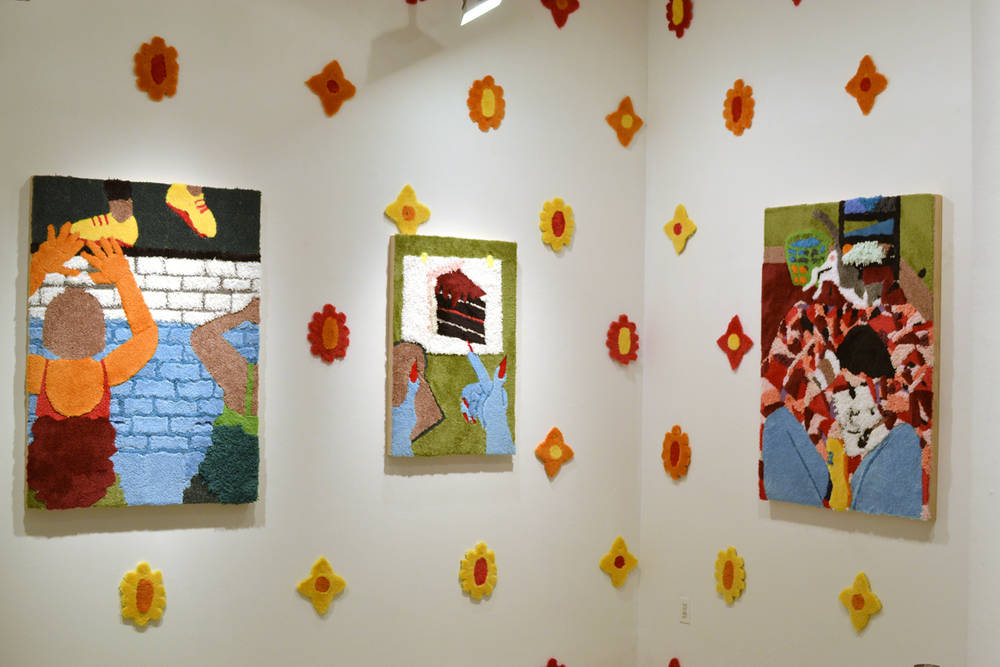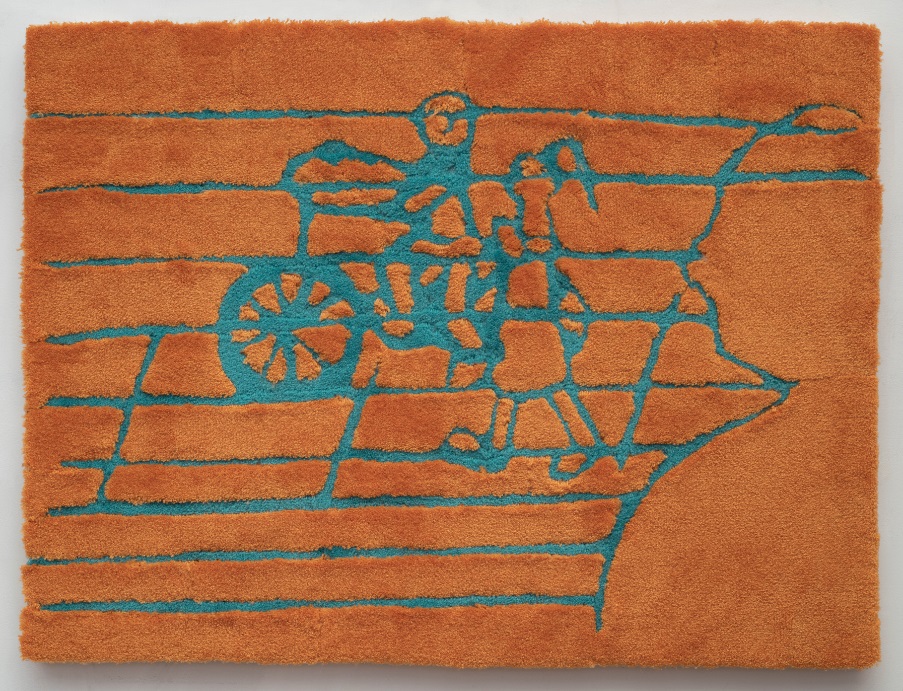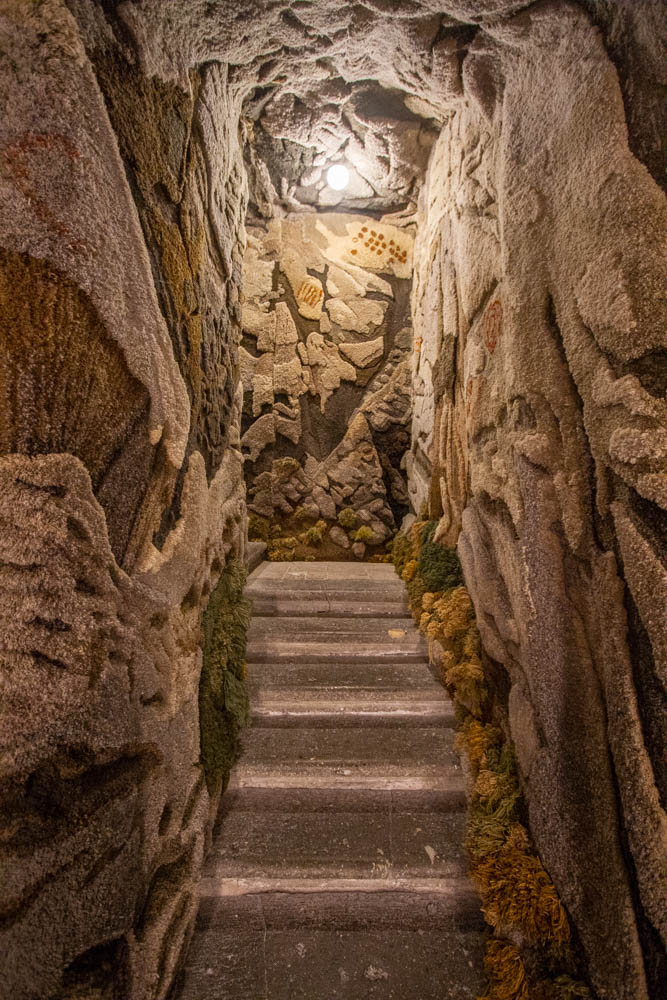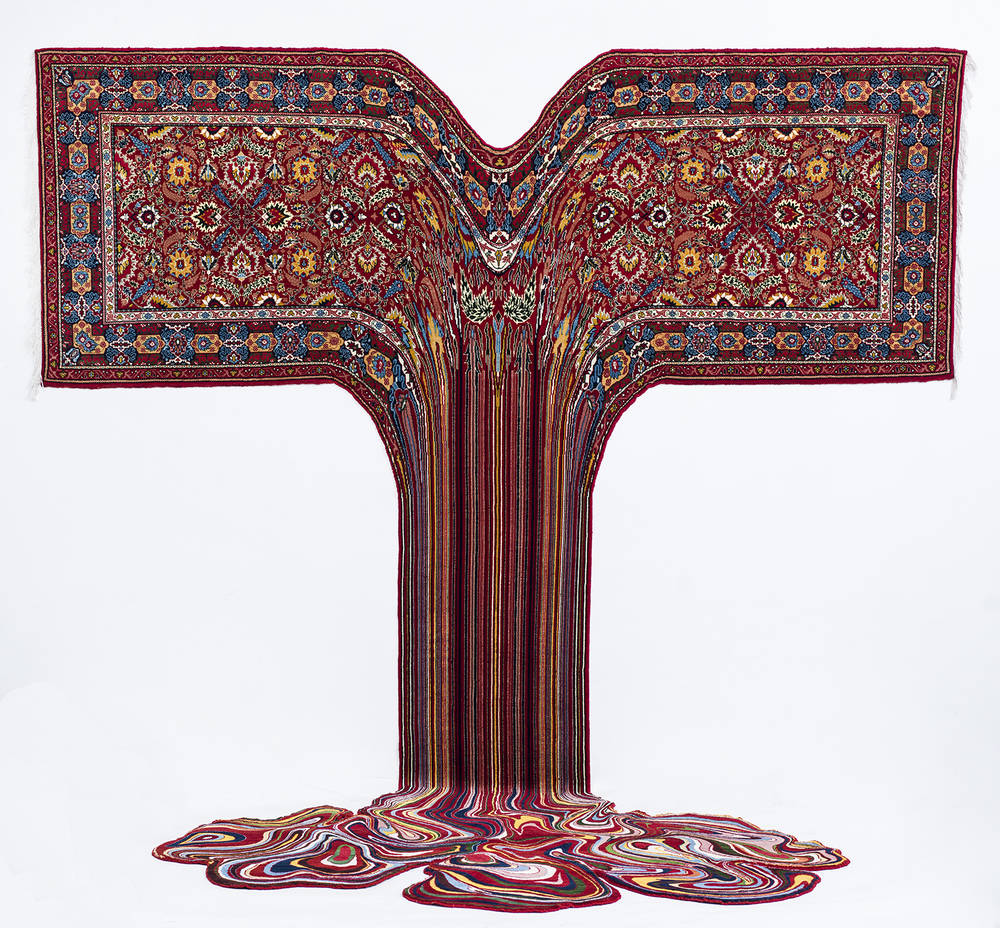Colorful cartoons, tufted caves and melting carpets: About the richness of contemporary tapestries.
The excessively rich tradition of a medium can be both a blessing and a curse. “After finishing art school I was obsessed with painting,” recalls Jessica Campbell. “I felt overwhelmed by its history and the voices of its forefathers, all the artists, all my painting professors seemed to be echoing around my studio.” Hence, continues the Canadian artist born in 1983, at a certain point she decided to turn to a rather less traditional art form.
An area where the field was not already saturated, where the precedents were indeed impressive, but where there was still sufficient space and scope for her own forward-thinking works. In 2014 Campbell began by cutting up bathmats and reassembling them to make new rugs. It was in 2016 that “the first pictures sprang onto the wall,” as she puts it, and thus she eventually ended up with her current medium, tapestry. The themes have a very specific quality, from which it’s not hard to trace the arc to Jessica Campbell’s second craft: drawing and writing comics. Campbell’s textile works are steeped in cartoon-like exaggeration, their forms somewhat coarse, the colors bright. Shading barely features; instead the artist might even create solid lines around specific forms and objects at times.
At the same time, this cartoon-like tendency is not a mere technicality, but rather determines the approach with regard to content too: Pop and everyday culture, art history, politics and more banal matters are all incorporated equally into her subject matter. And of course, as is often the case in contemporary art, it’s also about the considerations of “art on art”: the artist at work, from her own perspective, legs framing the subject left and right.
When asked about the dry humor that runs through many of her works and their accompanying titles, Jessica Campbell nods: “Humor is fundamental to the way in which I perceive and process the world around me. In spite of this, for a long time I kept humor out of my art, because it’s such a complex and challenging tool. It’s easy to make a brief, banal gag out of it, but that seems to me very unattractive. The best comedians use humor in a manner that opens up the way to what are otherwise downright ‘untouchable’ emotions and points of view.” Mike Kelley, she adds, “struck a marvelous balance between humor and trauma” as an artist. Bleak forebodings lurk here and there in the fibers of Campbell’s tapestries too, with their titles like “Watching (Harasser on a Bike)”.
When she was asked to do this interview, she says she felt honored: “Simply to be named in the same context as Ryggen…her work is so phenomenal, because there is this perfect combination of figures with complex settings, as well as references to politics, which are then also balanced out in turn with a cartoon-like vocabulary and a very clever, subtle color palette. I love her work!” The artist herself sees her current media as something that’s not set in stone.


“I wouldn’t call myself a ‘tapestry artist’, even though I love the processes involved in weaving and carpet-making,” says Campbell. The deconstruction was soon followed by a reconstruction of patterns and materials, and today the Chicago-dwelling artist creates textile works using various techniques, although she still always likes to create a mosaic or collage of sorts, something that is relatively rare in this medium, using inlay or tufting techniques. Here, yarn is applied to the already woven material basis from the outside, creating embellishments or raised patterns, for example.
Alexandra Kehayoglou has also chosen tufting as her favorite way of working: The artist, who was born in Buenos Aires in 1981, finishes her wall- and sometimes even room-filling tapestries in her own studio with the help of a tufting machine, one similar to those used in the carpet-making industry to produce for example floor coverings and car mats. Make no mistake, she says: The semi-automated way of working which today, unlike in preindustrial times, is still carried out by hand but with help from machines, also leads quite automatically to impressive results.
I wouldn’t call myself a ‘tapestry artist’, even though I love the processes involved in weaving and carpet-making.
From Kehayoglou’s studio, at any rate, the word is that the artist’s work process is “laborious and lengthy”, and demands “physical effort as well as a very precise technique.” The results are tapestries of virtually topographical precision that protrude into the space like landscapes formed of moss and stone. Sometimes, as in her series “What If All Is”, entirely hand-tufted caves are created with a complete textile covering from the floor to the walls to the ceiling.
Her feel for material and textures creates an impressive illusion
There are imitations of original landscapes that the artist has travelled through at some point and which she wants to preserve to an extent for posterity. Hence, Alexandra Kehayoglou is on the cusp of Actionist art, although her work wouldn’t fit in this category alone. Her keen sense for material and textures provides for an impressive illusionary experience; often it is only at second glance or with prior knowledge that you realize her works can technically be considered carpets. Tapestries are a medium that is relatively demanding in terms of prerequisites: You can experiment with it, of course, as with all other art mediums, but it does require an exceptionally high level of previous knowledge, planning and consideration.

The observation that the woven, knotted or tufted medium is currently “on the up” compared to the days of Hannah Ryggen or a textile artist like Annie Albers may indeed be accurate, yet in absolute figures there are still very few who could refer to themselves as established “textile artists”. Among these, in turn, there are many artists who – like Kehayoglou – come from a family with links to the medium.
Ahmed’s carpet art appears to become downright liquefied
Perhaps there is no one who better represents this necessary penetration of carpet-making almost in its very essence than Faig Ahmed: “Like any family in Azerbaijan, we had carpets everywhere – on the floors, on the walls, in each and every room,” explains the artist, who was born in Sumqayit in 1982. His works are brought to life by the absolute accuracy that provides for the initial moment of surprise. For example, the name of his series “Liquid” can be taken literally: Ahmed’s carpet art appears to become downright liquefied; what begins at the top as a traditional pattern melts into a conglomeration of colors below. Faig Ahmed gives his carpets flaws that are so perfect that they appear to be natural.
Elsewhere, he stretches out carpet patterns until they swell into bulges, or has apparently black liquid rain down on his pattern like an oil slick – with the fine difference that all these disruptions come not from the outside, but are worked into the carpet itself right from the beginning. So are they then even disruptions at all? Why do we perceive one thing as the correct form of the carpet and another not? As soon as the rules of the pattern are broken, the controlled chaos begins. Ahmed explains how he applies this to the carpet: “I create my sketches on the computer and then transfer these to special engineer’s paper, point by point. Then I pass my drawings on to the carpet-maker, who creates the carpet in the age-old way.”
The almost anachronistic process alone causes excitement
At the opposite end of this technical spectrum, one might place artists such as Ann Cathrin November Høibo or Diedrick Brackens: Both the former, a Norwegian artist born in 1979, and Brackens, who was born in Mexia, Texas in 1989, produce their works in their own studios. It goes without saying that in this digital age, this virtually anachronistic process creates a certain buzz in itself. And yet again it emerges that a medium alone does not signify common features beyond the technique applied: November Høibo, for example, slaves away formally on the tapestry, which often enough may consist of just a loosely connected weave featuring gaps and holes, or incorporated stones. The young Afro-American Brackens, meanwhile, works both figuratively and abstractly, often even combining the two.


Ann Cathrin November Høibo, Installation view, 2019, DREI, Courtesy of the artist, Image via amazonaws.com
He also includes a historical element in his incorporation of the people whose part in the long tradition of textile production, he believes, has never been adequately recognized – “Women, queers, and black and brown [sic] people,” as Brackens said in an interview with Artsy, have played and still play a huge role. And it’s true: Even today, beyond the art world and leisure pursuits, weaving textiles remains an exhausting job, and the days when people who were either economically or politically captive were forced to do it are not entirely in the past.
Self-empowerment, pride and pain literally interwoven in a piece of fabric
Brackens ultimately heaves his marginalized fellow men and women and their living situations with all their ambivalence onto his own textile works as motifs: self-empowerment, pride and pain literally woven into a piece of fabric. Composed of multiple strips and broken up by abstract patterns, Diedrick Brackens’ works thus yield what is perhaps the most appropriate form for a historical-personal perspective: a patchwork rug with a magical allure, which refuses to hide the painful knowledge of the tradition it forms part of.

Diedrick Brackens, in the decadence of silence, 2018, Image via www.vsf.la









